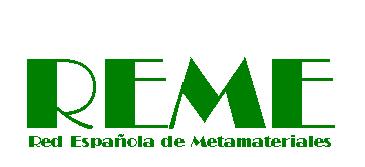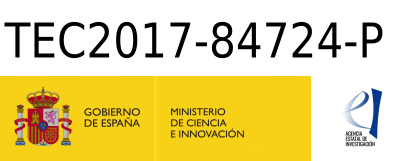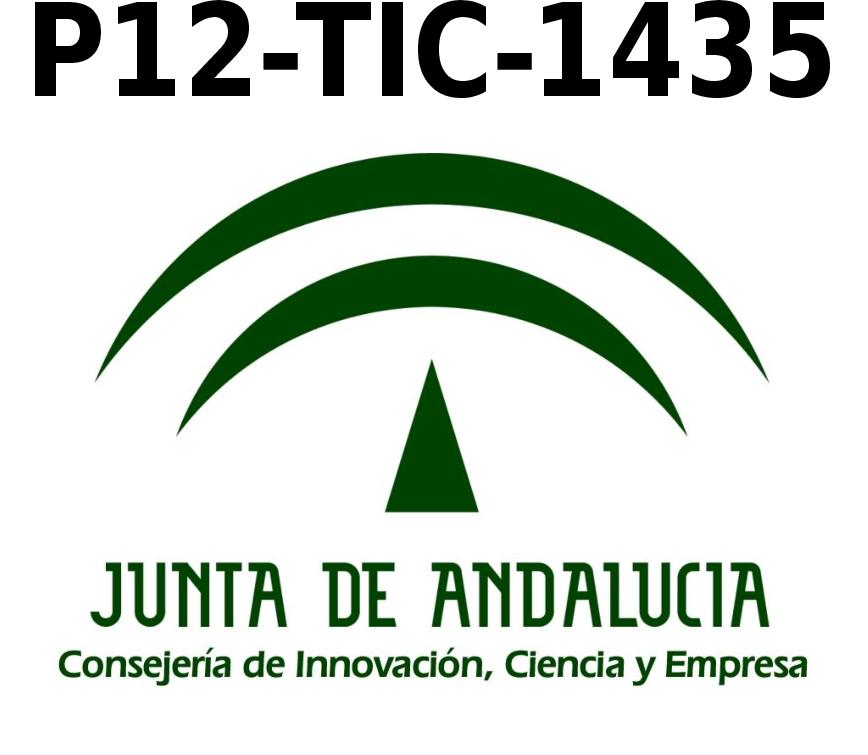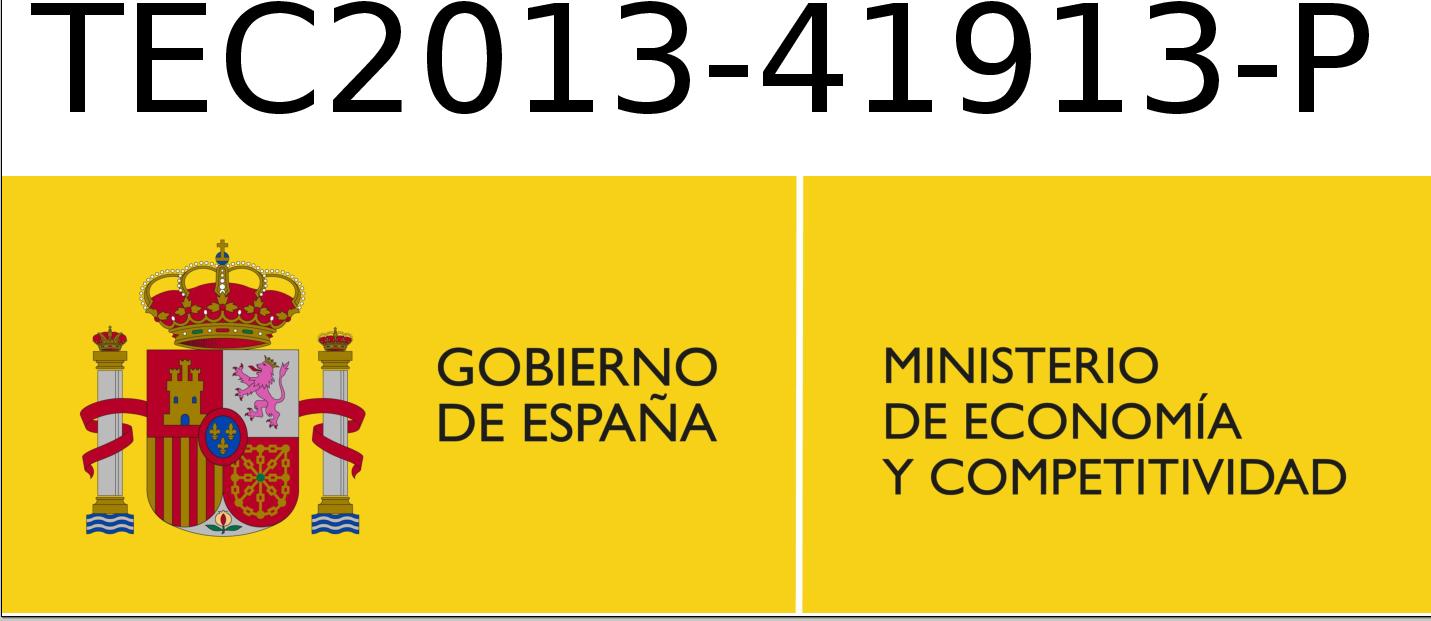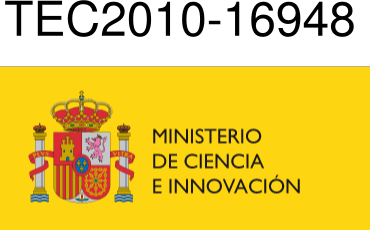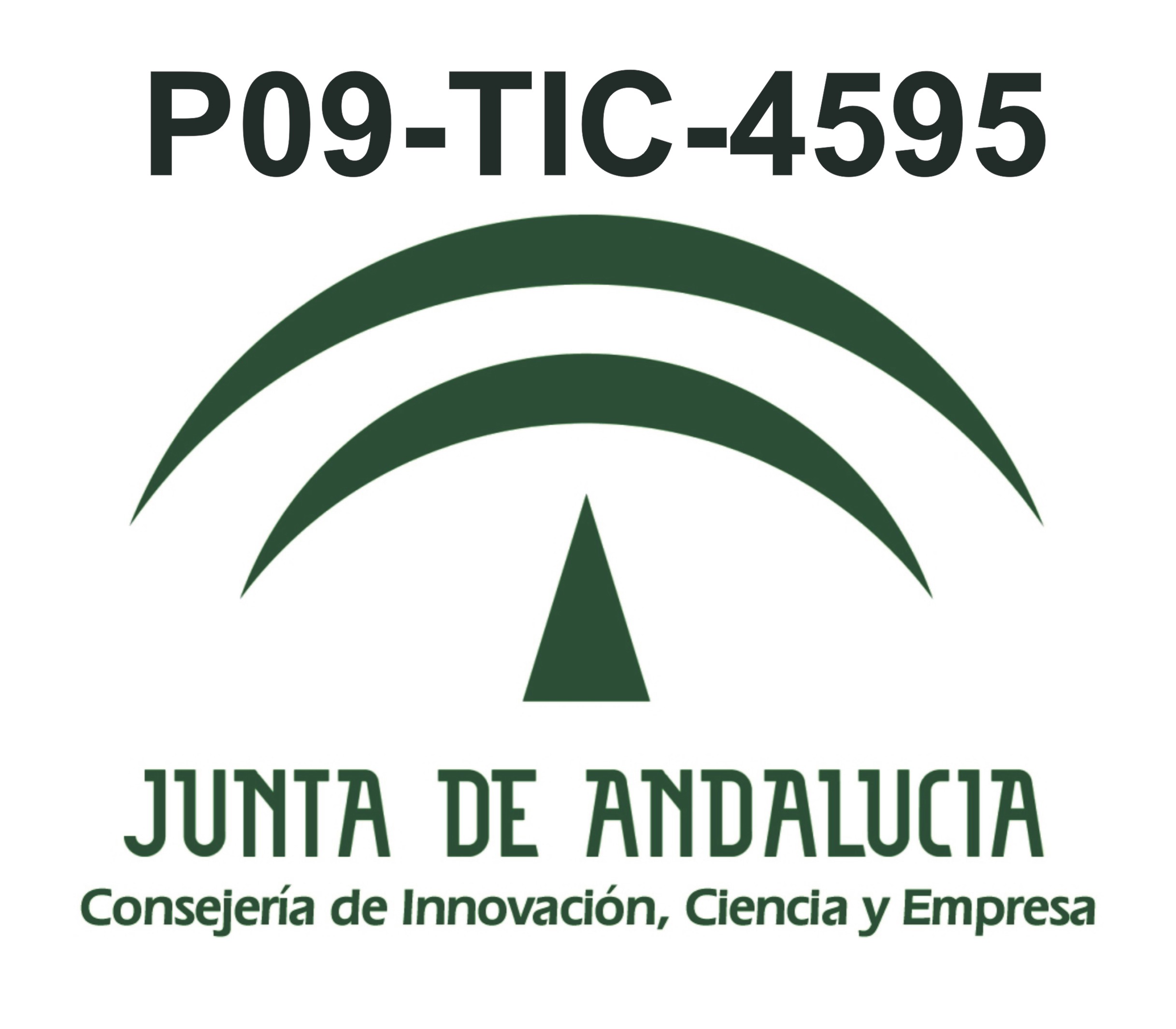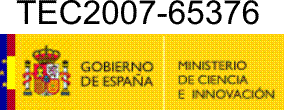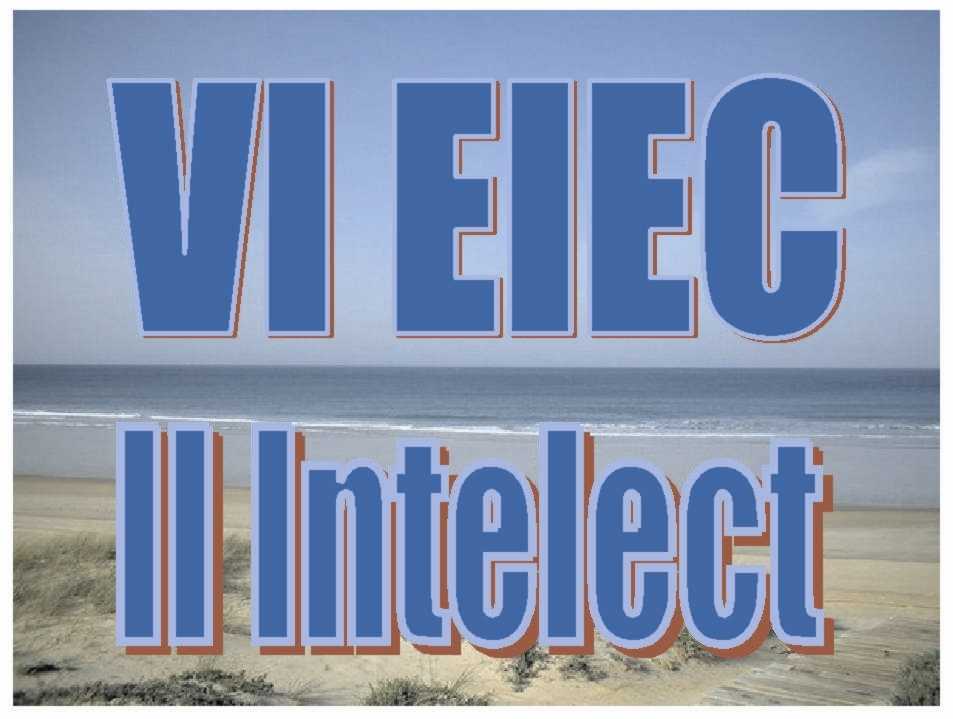Description and goals of project TEC2010-16948
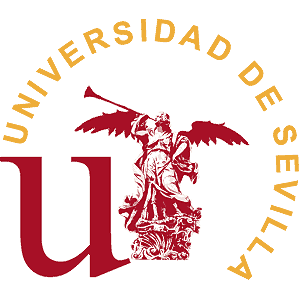


Description and goals of the project.
SUMMARY:
The present project can be considered a natural continuation of the research lines previously considered in projects TEC2007-65376 and TEC2007-68013-C02-01 by the members of the Microwaves Group of the University of Seville. Following the guidelines of the Ministry of Science and Innovation, the members of our research group have now preferred to join our efforts in a single "big" research project. Thus, we pretend to continue with several of our traditional general research lines although moving to new directions that involve new challenging advanced problems and more practically-oriented applications, with particular interest in the design on new passive components for communication systems and medical applications. In the frame of the present project, our investigation will focus on two general subjects:
- Characterization and applications of metamaterials, and
- Challenging propagation/radiation phenomena in planar structures.
1.1) Theory of fishnet metamaterials: Extension of our previous analysis on these structures to the cases of oblique incident and also to include the effects of realistic materials (losses and plasma behavior of metals at optical frequencies). The limits of the homogenization procedures will also be tackled.
1.2) Homogenization of resonant-ring metamaterials and analysis of size and edge effects. The very important practical issue of the building of an actual 3D metamaterial will be considered. In particular, it will be studied its topological and material requirements as well as the finite-size effects inherent to realistic realizations.
1.3) Design of metamaterials for magnetic resonance imaging. Since one of the most apparent applications of metamaterials turns out to be the enhancing of electromagnetic imaging, we pretend to continue our previous work on those topic to explore the possibilities of this emerging technology, paying special attention to its practical implementation.
Subject 2) Challenging propagation/radiation phenomena in planar structures.2.1) Analysis and design of periodic structures. We will focus our investigation in both the theoretical aspects and the practical realization of enhanced planar frequency-selective surfaces and leaky-wave antennas. Also it will be treated the plasmonic enhanced transmission/reflection properties of periodic screens.
2.2) Novel topologies for printed filters. We aim to develop new configurations for printed planar narrow and UWB filters, dual filters and other passive devices using hybrid microstrip/CPW structures, compact resonators and 1D periodic configurations.
2.3) High-frequency characterization of discontinuities. The appearance of new phenomena at high frequency (such as the excitation of leaky waves, residual waves, and radiation) can modify considerably the behavior of the discontinuities. Our investigation will focus on these high-frequency effects and its possible characterization via simplified circuit models.
2.4) Signal integrity in coupled printed lines. We will continue with our previous work on this relevant practical issue. In particular we will focus our attention on the crosstalk effects between neighbour lines in printed transmission structures due to the appearance of high-frequency spurious phenomena.
DESCRIPTION AND MAIN OBJECTIVES:The present proposal can be framed in the analysis and design of printed passive structures for microwave communication systems and medical applications. Our proposed analysis will cover theoretical, numerical, and experimental aspects of a variety of elements ranging from printed-circuit discontinuities to more complex filters, frequency-selective surfaces, leaky-wave antennas, resonant-ring elements, stacked periodic structures, and bulk metamaterials. More specifically, two different general subjects will be considered, namely, 1) Characterization and applications of metamaterials, and 2) Challenging propagation/radiation phenomena in planar structures.
1.- CHARACTERIZATION AND APPLICATIONS OF METAMATERIALS.
1.1.- Theory of fishnet metamaterials.
"Fishnet" was the name coined in the past few years for metamaterials made of stacked metallic plates perforated by periodic hole arrays. They were first proposed to obtain low-loss negative refractive index (NRI) metamaterials at near-infrared frequencies [1], and subsequently demonstrated at microwaves and terahertz frequencies [2,3], in the far-infrared frequency range [4], and in the visible range [5]. NRI was first observed at normal incidence in double fishnet structures [1,4], and later in multilayer structures [2,3] and prisms [3,4]. Recently, some of the proponents have developed an analytical theory of wave propagation through lossless fishnet structures [7], based on the previous analysis of extraordinary transmission through lossless metallic screens [6]. The proposed work is the continuation of these preliminary studies aimed to clarify some still obscure aspects of the characterization of fishnet metamaterials. In fact, although backward-wave propagation in the direction perpendicular to the metallic plates -and therefore NRI for normal incidence- is now well established in fishnet metamaterials, it is also clear that their characterization cannot simply rely on this parameter. First of all because an scalar NRI is only well defined for isotropic media, and fishnets are obviously anisotropic. In addition, fishnet periodicity along the direction parallel to the metallic layers is of the same order as the wavelength [7], which prevents homogenization in this direction. Therefore, fishnet metamaterials can be only partially homogenized, and this homogenization involves the solution of two main problems: i) the clear understanding of the meaning, limits and scope of fishnet homogenization, and ii) the definition and computation of the appropriate parameters for the partial homogenization of fishnet metamaterials.
1.2.- Homogenization of resonant-ring metamaterials and analysis of size and edge effects.
Although it is possible to find some precedents [8], it was after the seminal work of Pendry et al. [9] that artificial magnetic media made of resonant metallic rings become the subject of many studies, mainly aimed to the development of negative magnetic permeability metamaterials. Metallic resonant rings range from RF capacitively loaded rings [8] to split ring resonators (SRRs) [9,10], and are useful from microwaves to infra-red frequencies (at higher frequencies, the usefulness of SRRs for the design of negative permeability metamaterials is strongly limited by the effect of the kinetic inductance of electrons [11]). More recently, it has been shown by some of the proponents that high permittivity dielectric rings can play a similar role as SRRs at microwaves and THz frequencies [12]. Regarding applications, recent researches developed by some of the proponents suggest that bulk resonant ring metamaterials could find application in medical magnetic resonance imaging [13]. At higher frequencies, bulk SRR metamaterials could be useful in the design of artificial substrates, superstrates and lenses for antenna applications, and maybe in cloaking devices [14].
Homogenization is the key problem of the analysis of resonant-ring metamaterials, and a first analytical approach to this problem providing a reasonable agreement with experimental results and electromagnetic simulations is developed and discussed in [15]. However, the richness of phenomena appearing in resonant ring metamaterials is not captured by this first approach, mainly in the region of negative permeability, which is also the most interesting region from every point of view. Specifically, slow magnetoinductve waves arising from short range interactions between nearest rings [16] can be supported by bulk composites. These waves can substantially affect the behavior of such metamaterials in the aforementioned frequency band, and their effects are still not fully understood. It has been recently shown by some of the proponents that these waves can be taken into account by an homogenization procedure which includes spatial dispersion [17], opening a door for the further analysis of these effects. Another problems that appear in the analysis of the behavior of bulk resonant rings metamaterials come from the discrete and finite nature of actual designs. From practical and/or theoretical constrains, actual designs include a small number of unit cells along one or more dimension of the metamaterial. These discrete and finite effects can affect the behavior of the metamaterial, and must be analyzed. For instance, it has been shown that the behavior of resonant ring metamaterial lenses is substantially affected by the number of unit cells across the lens [18]. Other phenomena, such as the effect of the finite width of the lens should also be studied in more detail. According to all these considerations, the main objectives of this task are i) to further develop the homogenization theory of bulk and flat resonant ring metamaterials, and ii) to analyze the effects that may appear in these structure as a consequence of the finite number of unit cells and/or the presence of edges.
1.3.- Design of metamaterials for magnetic resonance imaging.
Magnetic Resonance Imaging (MRI) for medical applications at RF appears as a natural field of application of imaging by metamaterials. The interesting properties of most metamaterials occur in a very narrow band of frequencies due to the resonant nature of the elements that constitute the periodic structure. This narrow bandwidth is usually regarded as one of the main limitations of metamaterial applications. However, it is not a problem for MRI applications, because MR images are acquired by measuring RF signals inside a relatively narrow bandwidth of a few tens of kilohertz. In addition, since the wavelength associated with RF fields is of the order of the meters, it is possible to use conventional printed-circuit techniques to develop quasi-continuous metamaterials with constituent elements and periodicities two orders of magnitude smaller than the wavelength.
The application of metamaterials in MRI has been explored previously in several works [13,18,19-23]. Basically, it has been used two types of metamaterials corresponding to two different resonant elements. The first group are known as Swiss-roll metamaterials [19-22]. A Swiss roll consists of a conductive layer which is wound on a spiral path around a cylinder with an insulator separating consecutive turns. Reported experiments [19,20] proved that Swiss-roll metamaterials can guide the RF flux from a sample to a remote coil. In their applications, the Swiss-roll metamaterials mimic a medium with very high magnetic permeability at the proper frequency. The other group of metamaterials that have been applied to MRI are capacitively loaded split ring metamaterials [13,18,23]. Split rings have the key advantage over Swiss rolls of providing three-dimensional (3D) isotropy when they form a cubic lattice [13,18], which is an essential property if the device has to image 3D sources. A split ring is similar to a very small parasitic MR coil. However, whereas a MR coil works at resonance, the working frequency of split rings in a µr=-1 metamaterial lens differs from its frequency of resonance [13,18], which also helps to reduce losses and noise. It is the collective behaviour of split rings what provides the µr=-1 feature [18]. Split rings were used as constituent elements of a 3D lens that was fabricated and tested in a 1.5T MRI system [13]. Almost simultaneously, an accurate model for this design was developed [18]. The goal of this design was to provide a permeability µr=-1 at the Larmor frequency of the MRI system. An accurate analysis of the essential parameter in MRI, the signal-to-noise ratio (SNR), was provided in [23] for the device reported in [13].
Due to the long wavelengths involved in the RF range used in MRI, spatial location of the information in the MR image was traditionally achieved processing the phase and frequency of the measured signals. However, recent advanced techniques of parallel imaging [24] make use of the localized spatial sensitivity of MRI detector or coils to reduce acquisition time (the long acquisition time is a main drawback of MRI in comparison with X-ray computer tomography). Thus, another interesting application for metamaterial lenses is related to the techniques of parallel imaging. Basically it can be said that the use of metamaterial super-lenses can help to improve localization in parallel imaging and other MRI techniques due to the sub-diffraction imaging capabilities of these devices. Metamaterial slabs offer the possibility of manipulate the RF magnetic flux without interaction with the DC magnetic field of MRI scanners. In this sense, it would be of interest to investigate the applications of metamaterial slabs with permeability values different to -1, and specifically the case of zero permeability and high permeability. Finally, the results of the investigation with metamaterial lenses and metamaterial slabs with different permeabilities could also be extrapolated to Electron Magnetic Resonance Imaging which deals with frequencies in the microwave range. According to all these considerations, the main objectives of this task are i) to investigate the application of metamaterial lenses in parallel imaging, in particular, the localization of the FOV of MRI arrays of coils, and ii) to investigate the application of metamaterial slabs with permeability values different to -1, in particular the cases of zero permeability and high permeability.
Some international groups working on this subject are- Novel Electromagnetic Media. Group of Prof. David Smith, Duke University, Durham, NC, USA.
- Virtual Institute for Artificial Electromagnetic Materials and Metamaterials "Metamorphose VI AISBL" (leaded by Prof. Sergei Tretyakov, Aalto University, Helsinki, Finland).
- The Engheta group (leaded by Prof. Nader Engheta), University of Pennsylvania, Philadelphia, PE, USA.
- Electromagnetics Group (leaded by Prof. G. Eleftheriades), University of Toronto, Toronto, Canada.
2.- CHALLENGING PROPAGATION/RADIATION PHENOMENA IN PLANAR STRUCTURES.
2.1.- Analysis and design of periodic structures.
One of the objectives of the current proposal is the implementation of fast and accurate numerical codes for the electromagnetic analysis of planar periodic structures embedded in multi-layered dielectric media. In particular, we intend to study the scattering properties of planar periodic structures excited by plane waves, and the radiation properties of planar periodic structures excited by non-periodic dipole sources. The numerical codes for the scattering by layered periodic structures will be used in the design of frequency selective surfaces (FSS) [25], and those for the radiation of periodic structures will be used in the design of periodic leaky wave antennas (PLWA) [26,27]. Moreover, periodic structures can exhibit exotic electromagnetic responses when geometry or operation frequencies are chosen in a non-conventional way. Phenomena such as extraordinary transmission and reflection can also be studied with the help of those codes.
2.1.a.- Frequency Selective Surfaces.
FSSs have been the subject of intensive investigation due to their widespread applications as spatial microwave and optical filters for more than four decades [25]. FSSs are usually constructed from periodically arranged metallic patches of arbitrary geometries -or their complementary geometry, having aperture elements instead of patches. These surfaces exhibit total reflection / transmission for the patches/apertures in the neighbourhood of the element resonances. The most important step in the design of FSSs is the proper choice of constituting elements. The topological and material characteristics of these elements determine the overall frequency response of the structure, such as its bandwidth, transfer function, and its dependence on the incidence angle and polarization. In the last few years, many filter-theory concepts have been used in the design of FSSs. In fact, it has been proven that, by adequately choosing the number of layers, by choosing the resonant frequencies of the elements in each layer and by controlling the coupling between the elements in different layers, it is possible to design wideband FSSs [28], and multiband FSSs [29]. These are two of the topics that will be considered in the present project. Another interesting topic that has been recently addressed is the design of miniaturized FSSs. Whereas the usual size of the unit cell of FSSs is close to half wavelength, several researchers have recently designed FSSs with unit cell sizes below one tenth of a wavelength, which makes it possible to operate these FSSs at very low frequencies [30]. The topic of miniaturized FSSs is also expected to be treated in the frame of the current project. Indeed, some members of the research team have initiated preliminary work with significant success.2.1.b.- Periodic Leaky Wave Antennas.
Periodic Leaky Wave Antennas (PLWAs) exhibiting high-gain performance have recently attracted significant interest. Antennas of this type are formed when a partially reflective surface (PRS) is placed above a ground plane. The PRS consists of either a periodic array of metallic elements or a periodic array of apertures in a metallic screen. The resulting antenna is a type of Fabry-Pérot resonant cavity, and the thickness of the antenna is roughly half a wavelength. This thickness might be reduced by introducing a high permittivity substrate, but this decreases the antenna gain because of the excitation of substrate surface waves [27]. Very recently, several researchers have proven that the thickness of PLWAs can be substantially reduced below half-wavelength by introducing a second periodic array between the non-directive source and the ground plane [31,32]. In this project, following the guidelines given in [33], we intend to write a numerical code for the efficient computation of the radiation of a non-periodic dipole source embedded in a periodic multi-layered structure, and we want to explore the applications of this code to the design of low-profile PWLAs. The computation of the field generated by the dipole source in the periodic environment will also make it possible to address theoretical issues related to the excitation of bound and leaky modes in a periodic multi-layered structure. The members of the team have developed along the last year some concepts that can provide extra insight on the physical mechanisms behind the operation of that kind of antennas.
2.1.c.- Extraordinary Transmission (ET) Phenomena and surface waves.
Frequency Selective Surfaces (FSSs) mentioned in previous sections can be considered as particular cases of structured metallic surfaces. Standard operation of FSSs is based on the resonance of the specific metallic periodic pattern printed in the unit cell. The wavelength at the resonance frequency is larger than the size of the unit cell but of the same order of magnitude. Two interesting situations arise when this condition is not satisfied. It could happen that the intrinsic resonance frequency of the patch or slot patterned on the opaque screen is larger than the frequency at which the unit cell size is one wavelength (free space). It is known that, in such case, narrow band ET peaks appear close to the transmission dip associated with the Rayleigh-Wood's anomaly. This fact was accidentally discovered, a decade ago, at optical frequencies [34]. The surprise caused by this fact, in clear contrast with the well established Bethe's theory for small apertures, gave place to an explosion of research in the physics communities. Most of the contributions in this field correspond to the THz and optical spectra, but the underlying physics is the same for any frequency band provided no quantum or nonlinear effects are involved. Comprehensive reviews on the topic can be found in [35-37]. However, most of the published material deals with the physical mechanism underlying the phenomenon at optical frequencies (excitation of surface plasmon polaritons). In a recent paper [38], some of the members of the project team proposed an alternative point of view based on transmission-line circuit analogues that we consider more useful from the designer perspective. This point of view has shown its suitability to describe the behavior of a variety of periodic [39] or non-periodic [40] structures exhibiting ET. However, we have not carried out a systematic study of the influence of the various dimensional parameters on the behavior of the periodic structures. Moreover, the behavior of metals at very high frequencies (optical domain) is very different from the typical low frequency behavior (they behave as lossy plasmas rather than quasi-perfect conductors). It is then very important to include the specific behavior of materials in our methodology. On the other hand, ET is often related to the excitation of surface waves (such as surface plasmon polaritons) supported by the periodic structure. The analysis of the modal spectrum of such waves is not required to explain ET if the impedance matching concept is used. However, we can use the developed equivalent circuits to extract Brillouin dispersion diagrams with low computational effort. This strategy can be extended to the characterization of periodic structures operating far from the extraordinary transmission regime, in such a way that the study of FSSs and PLWAs above mentioned could strongly benefit from this research.
2.2.- Novel topologies for printed filters.
Microstrip and coplanar waveguide filter design has been another traditional research lines of the group along the last few years. Three different aspects will be studied in depth in the frame of this project: a) periodic filters; b) compact filters, and c) dual-band and multi-band filters. First, we will focus our attention on 1D periodic structures working as filters. For many practical purposes, some dynamic effects in these structures can be ignored and circuit-like models can be used to understand the main features of their behavior. Some of them have been understood for long [41]. For instance, the band structure of the dispersion diagrams of such systems has been used to exploit bandpass filtering properties (see, for instance, [42-44]). This kind of 1D filtering devices have been called "electromagnetic band gap" (EBG) structures. More recently, many concepts from the metamaterial pool have appeared in the field of filter design. Although a lot of research has been carried out in the last few years demonstrating the feasibility of compact and/or high performance filters based on those concepts (EBG and metamaterials), the authors of this proposal believe that the potential of periodic or quasi-periodic structures involving highly complex unit cells has not been completely exploited. For instance, it is possible to study the benefits of using compact semi-lumped resonators [45] or sections involving coupled microstrip and CPW building blocks [46]. When the number of unit cells is high, the structure can be considered an artificial transmission line, which could eventually be leaky at certain frequencies (antennas). This approach has been followed by a number of national and international groups. However, it is convenient to study the limitations of such approach. This task can be carried out by using rigorous full-wave approaches that make use of a great deal of analytical preprocessing. Some steps have been made in that direction [47,48], but we would try to develop better codes to completely understand the behavior of 1D periodic structures and their interaction with small size sources. However, concerning filter design, periodicity is not always desirable (at least it is not necessary). Indeed, some of the unit cells of the periodic structures can also be used to design standard Butterworth, Chebyshev, or elliptic filters. This can be achieved, for instance, by varying the parameters from cell to cell or allowing for cross couplings [49]. Our proposal is to use systematically the possibility of printing both sides of the substrates in order to reduce size and improve the electrical response of different type of filters, including low-pass, high-pass, narrow-band, and UWB filters. Some recent examples of this kind of work can be found in [50,51]. Dual-band and multi-band frequency filters will also be object of our interest, extending our initial experience in the field [52], but there are still many ideas that require time and effort to test and verify. This task is intended to be carried out in the frame of the present project.
2.3.- High-frequency characterization of discontinuities.
Although the study of discontinuities in microwave circuits has occupied hundreds of microwave engineers from long, most of the past effort has been devoted to their modelling at low and intermediate frequencies [53]. This has yielded a common understanding of the performance of the different discontinuities and, thus, they can be classified, roughly speaking, as inductive, capacitive, and radiative. However, at higher frequencies, the excitation of new components of the electromagnetic spectrum, and more specifically the so-called continuous spectrum [54] (leaky waves, residual waves, radiation into the background and/or free space) gives rise to new and unexpected phenomena that changes considerably the expected behavior of the lines and their discontinuities. Therefore, our proposal is to study in detail the high-frequency effects associated with the discontinuities at the light of the excitation theory previously developed by some of the member of our research group [55]. Our study will end up with the proposal of certain equivalent circuits results [56] that are expected to be coupled with data extracted from commercial CAD solvers. In this way, we would combine the capabilities of the commercial CAD solver with the advantages of having an accurate and simplified equivalent circuit model for the discontinuities, even at high frequencies. This hybrid procedure is expected to speed up considerably the CPU time required in the obtaining of the scattering parameters of systems with complex topologies.
2.4.- Signal integrity in coupled printed lines.
The field currently known as Electromagnetic Compatibility (EMC) covers many different areas such as the analysis and solution of problems related to the emission and susceptibility of the systems to the radiated and conducted electromagnetic interferences as well as to the effects of electrical discharges and nuclear pulses [57]. More specifically, in the integrated circuits area, the trend to increase the packaging density and the use of very high speed processing systems is giving rise to the appearance of certain high-frequency effects that were traditionally ignored. These high-frequency effects can complicate considerably the analysis and design of modern electronic systems but certainly they should be taken into account in order to improve the analysis/design procedures [58]. All this effort has given place to a new discipline commonly known as Signal Integrity [59]. In this new field, one of the most important and practical issues is the study of the crosstalk between neighbour transmission lines in printed microwave circuits and VLSI digital circuits. The wide experience of our research group in the study and characterization of printed lines is intended to be used to contribute in this emerging field. In fact, some of our last publications can be framed in the EMC and signal integrity areas [60-62].
Relevant international groups working on this field are:
- Applied Electromagnetic Group (Prof. D.R. Jackson, Prof. D.R. Wilton) University of Houston, Houston, TX, USA.
- Radiation Laboratory (Prof. Kamal Sarabandi), University of Michigan, Ann Arbor, MI, USA.
- Electromagnetic and Microwaves Laboratory (Prof. Kai Chang), University of Texas A&M, College Station, TX,USA.
- CIMITEC (Prof. Ferrán Martín), Universitat Autònoma de Barcelona, Barcelona, Spain
REFERENCES
[1] S. Zhang et al, Phys Rev. Lett., vol.95, 137404 (2005).
[2] M. Beruete et al, Optics Express, vol.14, 5445-5455 (2006).
[3] M. Beruete et al, IEEE Trans. on Microwave Theory and Tech., vol.55, 1514-1521 (2007).
[4] J. Valentine et al, Nature, vol.455, 299-300 (2008).
[5] G. Dolling et al, Optics Letters, vol.32, 53-55 (2007).
[6] R. Marqués et al, Optics Express, vol.17, 11582-11593 (2009).
[7] R. Marqués et al, Optics Express, vol.17, 5571-5579 (2009).
[8] S. A. Shelkunoff et al. ``Antennas. Theory and Practice.'' Wiley, New York, 1966 (3rd. ed.), p.548.
[9] J. B. Pendry et al, IEEE Trans. Microwave Theory Tech., vol. 47, pp. 2075 - 2084 (1999).
[10] T. J. Yen et al, Science, vol. 303, pp. 1494 -1496 (2004).
[11] J. Zhou et al, Phys. Rev. Lett., vol. 95, paper 223902 (2005).
[12] L. Jelinek et al, J. of Phys: Cond. Matt. vol. 22, paper no. 025902 (2010).
[13] M. J. Freire et al, Appl. Phys. Lett. Vol. 93, paper no. 231108 (2008).
[14] D. Schurig et al, Science, vol.314, pp. 977-980 (2006).
[15] R. Marqués et al, ``Metamaterials with negative parameters''. Jhon Wiley & Sons, Hoboken, NJ, 2008, (Chapter 2).
[16] E. Shamonina et al, J. Appl. Phys., vol. 92, pp. 6252 - 6261 (2002).
[17] J. D. Baena et al, Phys. Rev. A, vol. 78, paper no. 013842 (2008).
[18] L. Jelinek et al, J. Appl. Phys., vol. 105, paper no. 024907 (2009).
[19] C.K. Wiltshire et al, Science vol. 291, pp. 849-851 (2001).
[20] V.C. Behr et al, Concepts in Magnetic Resonance Part B (Magnetic Resonance Engineering) 23B(1) pp. 44-49 (2004).
[21] M. Allard et al, Proc. Intl. Soc. Mag. Reson. Med. vol.13 pp.871 (2005).
[22] A. Mathieu et al, J. Magn. Reson. Vol. 182, pp. 200-207 (2006).
[23] M.J. Freire et al, J. Magn. Res. (20010), doi:10.1016/j.jmr.2009.12.005.
[24] M.A. Griswold et al, Magn. Reson. Med. vol. 44, pp. 602-609 (2000).
[25] B.A. Munk, Frequency Selective Surfaces: Theory and Design, New York, Wiley (2000).
[26] A.A. Oliner et al, Antenna Engineering Handbook, 3rd ed. New York: McGraw-Hill, 1993, ch. 10.
[27] T. Zhao et al, IEEE Trans. on Antennas and Propagat., vol. 53, pp. 3505-3514 (2005).
[28] A. Abbaspour-Tamijani et al., IEEE Trans. on Mic. Theory Tech., vol. 52, pp. 1781-1788 (2004).
[29] K. Sarabandi et al, IEEE Trans. on Antennas and Propagat., vol. 55, pp. 1239-1245 (2007).
[30] F. Bayatpur et al., IEEE Trans. on Mic. Theory Tech., vol. 56, pp. 774-781 (2008).
[31] A.P. Feresidis et al., IEEE Trans. on Antennas and Propagat., vol. 53, pp. 209-215 (2005).
[32] Kelly et al, IEEE Trans. on Antennas and Propagat., vol. 56, pp. 2817-2825 (2008).
[33] F. Capolino et al, Theory and Phenomena of Metamaterials, Boca Raton FL: CRC Press, ch. 12 (2009).
[34] T.W. Ebbesen et al, Nature, vol. 391, pp. 667-669 (1998).
[35] F.J. García de Abajo, Rev. Modern Phys., vol. 79, pp. 1267-1290 (2007).
[36] C. Genet et al, Nature, vol. 445, pp. 39-46, (2007).
[37] F.J. García-Vidal, Rev. Mod. Phys., (2010).
[38] F. Medina et al, IEEE Trans. on Mic. Theory Tech., vol. 56, pp. 3108-3120 (2008).
[39] F. Medina et al, IEEE Trans. on Mic. Theory Tech., vol. 58, pp. 105-115 (2010).
[40] F. Medina et al, App. Phys. Lett., vol. 95, pp. 071102 (2009).
[41] R.E. Collin, Field Theory for Guided Waves, IEEE Press, Piscataway NJ, USA (1991).
[42] J.-S. Hong et al, IEEE Trans. on Mic. Theory Tech., vol. 45, pp. 2358-2365 (1997).
[43] J. Martel et al, IEE Elect. Lett., vol. 34,, pp. 867-868 (1998).
[44] M.A.G. Laso et al, IEEE Mic. Guided Wave Lett., vol. 10, pp. 220-222 (2000).
[45] J. Martel et al, IEEE Mic. and Wireless Comp. Lett., vol. 17, pp. 28-30 (2007).
[46] M.C. Velázquez-Ahumada et al, IEEE Trans. on Microw. Theory and Techn., vol. 55, n. 1, pp. 121-127 (2007).
[47] R. Rodriguez-Berral et al., 2007 IEEE IMS, Honolulu, Hawaii, EEUU, pp. 1667-1670 (2007).
[48] G. Valerio et al., Radio Science, vol. 43, RS1009, doi:10.1029/2007RS003697, 2008.
[49] J.-S. Hong et al., Microstrip Filters for RF/Microwave Applications, John Wiley & Sons, Inc. 2001.
[50] A. Vélez et al., IEEE Mic. and Wireless Comp. Lett., vol. 19, no. 4, pp. 197-199 (2009).
[51] M.C. Velázquez-Ahumada et al., 39th European Microwave Conference, (Rome, Italy) , pp. 307-310 (2009).
[52] M.C. Velázquez-Ahumada et al., IEEE IMS (Boston, EEUU), pp. 857-860 (2009).
[53] K.C. Gupta et al, Microstriplines and slotlines, Artech House, 2nd Edt. (1996).
[54] D.R. Jackson et al, Radio Science, vol. 35, pp. 495-510 (2000).
[55] M.J. Freire et al, IEEE Trans. on Microw. Theory and Techn., vol. 49, n. 12, pp. 2206-2215 (2001).
[56] R. Rodriguez-Berral et al., Accepted in 2010 IEEE IMS, (Anaheim, CA, EEUU), May 2010.
[57] C.R. Paul, Introduction to Electromagnetic Compatibility , John Wiley Interscience, NY, second edition (2006).
[58] M. Montrose, Printed Circuit Board Design Techniques for EMC Compliance ,IEEE Press, second edition (2000).
[59] S.H.Hall and H.L.Heck, Advanced Signal Integrity for High-Speed Digital Designs ,John Wiley and Sons, 2009.
[60] J. Bernal et al, IEEE Trans. Microwave Theory and Tech., vol.52, no.8, pp.1770-1780 (2004).
[61] J. Bernal et al, IEEE Trans. Microwave Theory and Techn.} vol.55, no.7, pp.1511-1519 (2007).
[62] J. Bernal et al, in Proc. of USNC/URSI National Radio Science Meeting , Charleston, SC, USA (2009).
3.- OBJECTIVES.
3.1.- Reasons to present this proposal / hypothesis.
This proposal focuses on two different but partially complementary research lines sharing similar methodological and experimental resources. The common point underlying both research lines is the study of RF and microwave planar/quasi-planar structures. For our first research line (metamaterials) the recognized background of our research group in this topic makes us realize that many aspects of the investigation on metamaterials are currently carried out without the sufficient electromagnetic rigour (for instance, erroneous homogenization, retrieval of parameters, wrong assumption on the isotropy character, neglect of scale and finite-size effects, etc). Thus it is our intention to fill these gaps providing the underlying theoretical and numerical tools that are necessary for a good comprehension and practical use of metamaterials. Also, we are confident that one of the most interesting application of the exotic electromagnetic characteristic of metamaterials lies in their use in magnetic resonance imaging (MRI). In this medical imaging application, many of the standard problems of metamaterials (narrow-band behavior, losses, homogenization, anisotropy) are overcome, mainly because of the frequency range of MRI. In our second research line (propagation/radiation in planar structures) our initial hypothesis are that, despite of the considerably maturity level of the involved topics, there are still many open problems (development of efficient algorithms for computing Green's functions, numerical efficiency of CAD codes, controversial theoretical questions, good understanding of unexpected high-frequency effects) that the contrasted theoretical/practical background of our research group can contribute significantly.
3.2.- Background and previous results.
First of all it should be said that due to the variety of topics included in this proposal we cannot go into the details of the background and previous results of our group in each one of these topic. Instead we are going to give a general overview of the the background and previous results of our group that can support our hypothesis in the present proposal. Several of the researchers involved in this project have a long experience in the theoretical, numerical, and experimental aspects associated with the topics included in the proposal. This past work has given rise to continuous publications of many papers in the most important scientific forums of the RF/microwave engineering and physics areas: 1 book on Metamaterials, 8 book chapters, 240 papers in international journals (111 in IEEE journals, of which 84 are in IEEE Transactions on Microwave Theory and Techniques and 11 in other IEEE Transactions periodicals), about 260 international conference papers or abstracts, 132 national conference papers, and 10 patents (excluding contributions of foreign members of the research team). In particular, one the members of the group, Ricardo Marqués, is an international leader in the field of metamaterials, and his activity in the kind of theoretical and practical problems considered in this proposal makes him a regular plenary speaker in international conferences on metamaterials and related topics. The principal researcher, Francisco Mesa, has numerous contributions on the analysis of the nature of the fields in planar structures, including continuous and periodic configurations. Most of that work was carried out in close collaboration with Prof. David R. Jackson and coworkers, and Prof. Arthur Oliner, who are considered international leaders in the field. Francisco Medina has published extensively on planar structures and, more recently, in collaboration with the above mentioned researchers, has developed a new paradigm to explain extraordinary transmission phenomena. He has also carried out significant work on printed passive devices. His contributions to all those topics have been recently recognized by IEEE through his elevation to the grade of IEEE Fellow. Rafael R. Boix and Francisco Mesa have developed a notorious activity on the numerical modeling of periodic structures by means of integral equation techniques. They have published several key papers on the topic. Alexander Yakovlev has a strong background on the study of periodic metallo-dielectric structures as surface waveguides. Thus, in brief, the theoretical assumptions behind the physics and methods involved in this project are well founded on the previous experience and know how of the leading members of the research team.3.3.- Specific objectives of this project.
- A clear understanding of the meaning, limits and scope of fishnet homogenization as well as the definition and computation of the appropriate parameters for the partial homogenization of fishnet metamaterials.
- Further development of the homogenization theory for bulk and flat resonant ring metamaterials.
- Analysis of the effects that may appear in resonant ring metamaterials as a consequence of the finite number of unit cells and/or the presence of edges.
- To investigate the application of metamaterial lenses in parallel imaging, in particular, the localization of the field of view of MRI arrays of coils.
- To investigate the application of metamaterial slabs with permeability values different of -1, with particular interest in the cases of zero permeability and high permeability.
- Implementation of a fast and accurate numerical codes for the electromagnetic analysis of planar periodic structures embedded in multilayered dielectric media. Two types of excitations will be considered: plane waves and non-periodic dipole sources.
- Application of the above codes to the design of frequency selective surface (FSS) and periodic leaky-wave antennas (PLWA) with enhanced performance.
- Derivation of simple equivalent circuit model to compute the scattering parameters of periodic structured screens embedded in layered media. Application of these simplified models to the synthesis of FSSs, PLWAs, and the study of extraordinary transmission/reflection systems.
- Design of novel planar miniaturized filters that exploit the potentials of periodic or quasi-periodic structures involving highly complex unit cells.
- To exploit the possibilities of printing both sides of the substrates in order to reduce size and improve the electrical response of different types of planar filters.
- Implementation of new circuit models to characterize the behavior of discontinuities at high frequencies.
- Study of the high-frequency crosstalk in neighborh printed lines with application to the study of the pulse distortion in coupled printed lines and data buses.

